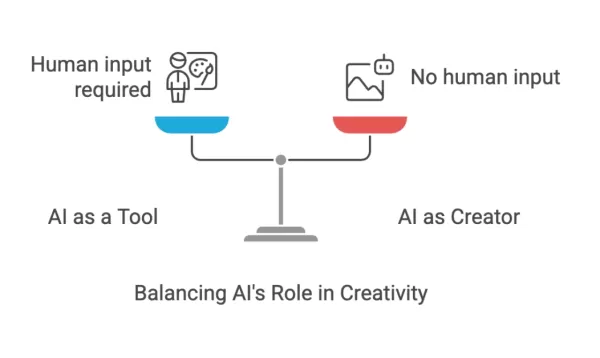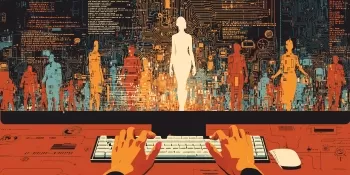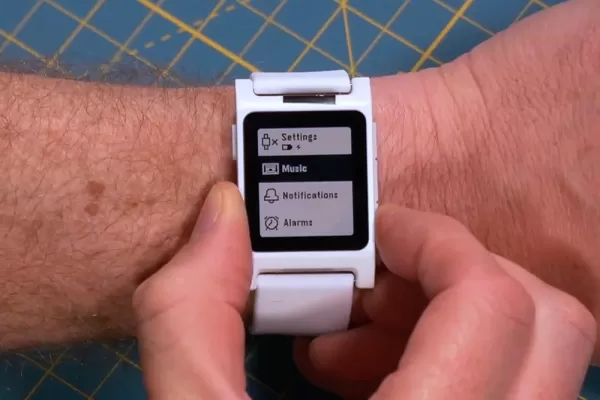US Copyright Office Unveils New AI Guidelines: Key Points to Understand
The US Copyright Office has recently released a significant report that clarifies the murky waters of AI and copyright ownership. This guidance is crucial for understanding who holds the rights to content created with AI assistance.
At the heart of the matter is human creativity. The Copyright Office emphasizes that copyright protection is rooted in human creative input, not in the AI systems themselves. Simply hitting "generate" on an AI tool does not grant you ownership of the output.
However, the Office isn't dismissing AI outright. They're encouraging creators to demonstrate the human touch in their work. The key is distinguishing between using AI as a tool (which can be protected) and allowing AI to make all the creative decisions (which cannot).
Here are the core principles to keep in mind:
Human Authorship is Essential
- Copyright protection hinges on human creative input.
- AI systems are seen as tools, similar to cameras or paintbrushes.
- The critical question is whether the work is fundamentally authored by a human.
The Prompt Paradox
- Detailed prompts alone generally won't secure copyright protection.
- The Office likens it to rolling dice—you might keep trying until you get what you want, but you're not controlling the outcome.
- Merely selecting your favorite AI output isn't considered a creative act.
What Actually Counts
- Direct modifications to AI outputs.
- Creative arrangements of AI-generated material.
- Your original content that remains visible in the final work.
These principles are particularly relevant as we witness rapid advancements in technologies like AI image and music generation.
What Counts as Human Authorship?
Understanding what the Copyright Office considers "human authorship" is vital for securing legal protection for AI-assisted work.
What is human authorship?
The Office defines an author as "the person who translates an idea into a fixed, tangible expression." When it comes to AI, they seek clear evidence that a human made the key creative decisions.
An experiment conducted by the Copyright Office illustrates why prompts alone aren't sufficient. Even with complex, detailed instructions, the AI made its own creative choices about what to include. This experiment highlighted that prompts don't equate to authorship—you're not controlling the creative decisions; the AI is.
 (US Copyright Office)
(US Copyright Office)
Consider this: even with identical prompts, AI systems can produce different results each time. You might like what you get, but you're not directing the creative process—you're just choosing from what the AI decides to create.
What actually qualifies as authorship:
Active Creation
- Making substantial changes to AI outputs.
- Combining AI-generated elements in original ways.
- Adding your own creative work that remains visible in the final product.
Creative Control
- Guiding the artistic vision.
- Making specific design choices.
- Determining how elements come together.
Documented Human Input
- Your original content mixed with AI assistance.
- Clear evidence of your creative decisions.
- Traceable human modifications.
These standards emphasize that using AI is acceptable, but you must demonstrate how you've shaped the final work with your own creativity.
 (Alex McFarland/Unite AI)
(Alex McFarland/Unite AI)
Requirements for Protection
The Copyright Office has outlined specific technical requirements for registering AI-assisted work. These details are crucial.
When registering, you must disclaim "any non-human expression," clearly separating what you created from what the AI generated. The Office looks for human authorship that is "clearly perceptible" and distinguishable from AI-generated elements.
This presents a technical challenge. You'll need to track and document your creative process differently, highlighting the line between human and machine contributions. The goal is not to restrict AI use but to protect human creativity.
Think of it as version control for your creativity. Savvy creators are documenting their process, saving iterations, tracking significant modifications, and maintaining clear records of their original contributions.
The international perspective adds another layer. While most countries agree that copyright requires human authorship, some have different approaches.
If you're considering global distribution of AI-created work, be aware that the approach to AI copyright isn't uniform worldwide.
Most major countries align with the US view that copyright needs human creativity. Korea, Japan, China, and the Czech Republic all agree on this core principle. However, some countries have unique rules.
The UK and New Zealand have special provisions for "computer-generated works," though these are being reevaluated as AI evolves. Canada is still figuring things out, reflecting the rapid changes in this field.
Your Guide to AI Copyright Success
Success with AI copyright isn't about avoiding AI; it's about using it smartly.
Start with your creative vision. Use AI as a tool to enhance your work, not replace your creativity. Document your process, showing how you guided the creative direction.
Smart creators treat their AI projects like any other creative endeavor. They save versions, track changes, and keep clear records of their original input.
When registering your work, clearly distinguish between what's yours and what's AI-generated. Make this easier by documenting as you go.
The Copyright Office recognizes that we're just beginning to explore AI's potential. They're monitoring technological advancements and how creators use them. They'll likely update their guidance as new developments emerge.
But don't wait for perfect rules. The core principle remains unchanged: human creativity is paramount. The Office is confident that existing copyright law suffices for now.
What matters most is showcasing your creative voice. The winners will be those who balance human creativity with AI assistance effectively.
To stay ahead, keep documenting your process, maintain your creative control, and watch for updates from the Copyright Office. Your creative future depends on it.
Related article
 Manus Debuts 'Wide Research' AI Tool with 100+ Agents for Web Scraping
Chinese AI innovator Manus, which previously gained attention for its pioneering multi-agent orchestration platform catering to both consumers and professional users, has unveiled a groundbreaking application of its technology that challenges convent
Manus Debuts 'Wide Research' AI Tool with 100+ Agents for Web Scraping
Chinese AI innovator Manus, which previously gained attention for its pioneering multi-agent orchestration platform catering to both consumers and professional users, has unveiled a groundbreaking application of its technology that challenges convent
 Why LLMs Ignore Instructions & How to Fix It Effectively
Understanding Why Large Language Models Skip Instructions
Large Language Models (LLMs) have transformed how we interact with AI, enabling advanced applications ranging from conversational interfaces to automated content generation and programming ass
Why LLMs Ignore Instructions & How to Fix It Effectively
Understanding Why Large Language Models Skip Instructions
Large Language Models (LLMs) have transformed how we interact with AI, enabling advanced applications ranging from conversational interfaces to automated content generation and programming ass
 Pebble Reclaims Its Original Brand Name After Legal Battle
The Return of Pebble: Name and AllPebble enthusiasts can rejoice - the beloved smartwatch brand isn't just making a comeback, it's reclaiming its iconic name. "We've successfully regained the Pebble trademark, which honestly surprised me with how smo
Comments (15)
0/200
Pebble Reclaims Its Original Brand Name After Legal Battle
The Return of Pebble: Name and AllPebble enthusiasts can rejoice - the beloved smartwatch brand isn't just making a comeback, it's reclaiming its iconic name. "We've successfully regained the Pebble trademark, which honestly surprised me with how smo
Comments (15)
0/200
![CharlesScott]() CharlesScott
CharlesScott
 April 26, 2025 at 3:37:57 AM EDT
April 26, 2025 at 3:37:57 AM EDT
The new AI guidelines from the US Copyright Office are a bit of a headache to understand, but super important! It's all about who owns what when AI gets involved. Wish it was simpler, but glad for the clarity! 🤓


 0
0
![LarryMartin]() LarryMartin
LarryMartin
 April 26, 2025 at 1:46:12 AM EDT
April 26, 2025 at 1:46:12 AM EDT
미국 저작권국의 새로운 AI 가이드라인을 이해하는 건 조금 어렵지만 정말 중요해요! AI가 개입될 때 누가 무엇을 소유하는지에 대한 내용이죠. 좀 더 간단했으면 좋겠지만, 명확해져서 다행이에요! 😊


 0
0
![JimmyGarcia]() JimmyGarcia
JimmyGarcia
 April 23, 2025 at 9:49:10 PM EDT
April 23, 2025 at 9:49:10 PM EDT
As novas diretrizes de IA do Escritório de Direitos Autorais dos EUA são um pouco complicadas de entender, mas são super importantes! Tudo sobre quem é dono do quê quando a IA está envolvida. Desejaria que fosse mais simples, mas estou feliz pela clareza! 😅


 0
0
![FrankSmith]() FrankSmith
FrankSmith
 April 23, 2025 at 5:30:14 PM EDT
April 23, 2025 at 5:30:14 PM EDT
Las nuevas directrices de IA de la Oficina de Derechos de Autor de EE. UU. son un poco difíciles de entender, pero son muy importantes. Todo sobre quién posee qué cuando la IA está involucrada. Ojalá fueran más simples, pero me alegra la claridad. 😊


 0
0
![EricRoberts]() EricRoberts
EricRoberts
 April 23, 2025 at 1:44:51 PM EDT
April 23, 2025 at 1:44:51 PM EDT
アメリカ著作権局の新しいAIガイドラインを理解するのは少し大変ですが、とても重要です!AIが関わるときの所有権についての内容です。もう少し簡単であれば良かったのですが、明確さが得られて良かったですね!😅


 0
0
![RalphJohnson]() RalphJohnson
RalphJohnson
 April 20, 2025 at 1:32:20 PM EDT
April 20, 2025 at 1:32:20 PM EDT
アメリカの著作権局が出したAIに関する新しいガイドライン、めっちゃ助かる!AIが関わるときに誰が何を所有するのか、ようやく明確になったね。ちょっと読みにくいけど、AIを使ったアートや文章をやってる人には必読だね。もっとシンプルなバージョンが欲しいな😂


 0
0
The US Copyright Office has recently released a significant report that clarifies the murky waters of AI and copyright ownership. This guidance is crucial for understanding who holds the rights to content created with AI assistance.
At the heart of the matter is human creativity. The Copyright Office emphasizes that copyright protection is rooted in human creative input, not in the AI systems themselves. Simply hitting "generate" on an AI tool does not grant you ownership of the output.
However, the Office isn't dismissing AI outright. They're encouraging creators to demonstrate the human touch in their work. The key is distinguishing between using AI as a tool (which can be protected) and allowing AI to make all the creative decisions (which cannot).
Here are the core principles to keep in mind:
Human Authorship is Essential
- Copyright protection hinges on human creative input.
- AI systems are seen as tools, similar to cameras or paintbrushes.
- The critical question is whether the work is fundamentally authored by a human.
The Prompt Paradox
- Detailed prompts alone generally won't secure copyright protection.
- The Office likens it to rolling dice—you might keep trying until you get what you want, but you're not controlling the outcome.
- Merely selecting your favorite AI output isn't considered a creative act.
What Actually Counts
- Direct modifications to AI outputs.
- Creative arrangements of AI-generated material.
- Your original content that remains visible in the final work.
These principles are particularly relevant as we witness rapid advancements in technologies like AI image and music generation.
What Counts as Human Authorship?
Understanding what the Copyright Office considers "human authorship" is vital for securing legal protection for AI-assisted work.
What is human authorship?
The Office defines an author as "the person who translates an idea into a fixed, tangible expression." When it comes to AI, they seek clear evidence that a human made the key creative decisions.
An experiment conducted by the Copyright Office illustrates why prompts alone aren't sufficient. Even with complex, detailed instructions, the AI made its own creative choices about what to include. This experiment highlighted that prompts don't equate to authorship—you're not controlling the creative decisions; the AI is.
 (US Copyright Office)
(US Copyright Office)
Consider this: even with identical prompts, AI systems can produce different results each time. You might like what you get, but you're not directing the creative process—you're just choosing from what the AI decides to create.
What actually qualifies as authorship:
Active Creation
- Making substantial changes to AI outputs.
- Combining AI-generated elements in original ways.
- Adding your own creative work that remains visible in the final product.
Creative Control
- Guiding the artistic vision.
- Making specific design choices.
- Determining how elements come together.
Documented Human Input
- Your original content mixed with AI assistance.
- Clear evidence of your creative decisions.
- Traceable human modifications.
These standards emphasize that using AI is acceptable, but you must demonstrate how you've shaped the final work with your own creativity.
 (Alex McFarland/Unite AI)
(Alex McFarland/Unite AI)
Requirements for Protection
The Copyright Office has outlined specific technical requirements for registering AI-assisted work. These details are crucial.
When registering, you must disclaim "any non-human expression," clearly separating what you created from what the AI generated. The Office looks for human authorship that is "clearly perceptible" and distinguishable from AI-generated elements.
This presents a technical challenge. You'll need to track and document your creative process differently, highlighting the line between human and machine contributions. The goal is not to restrict AI use but to protect human creativity.
Think of it as version control for your creativity. Savvy creators are documenting their process, saving iterations, tracking significant modifications, and maintaining clear records of their original contributions.
The international perspective adds another layer. While most countries agree that copyright requires human authorship, some have different approaches.
If you're considering global distribution of AI-created work, be aware that the approach to AI copyright isn't uniform worldwide.
Most major countries align with the US view that copyright needs human creativity. Korea, Japan, China, and the Czech Republic all agree on this core principle. However, some countries have unique rules.
The UK and New Zealand have special provisions for "computer-generated works," though these are being reevaluated as AI evolves. Canada is still figuring things out, reflecting the rapid changes in this field.
Your Guide to AI Copyright Success
Success with AI copyright isn't about avoiding AI; it's about using it smartly.
Start with your creative vision. Use AI as a tool to enhance your work, not replace your creativity. Document your process, showing how you guided the creative direction.
Smart creators treat their AI projects like any other creative endeavor. They save versions, track changes, and keep clear records of their original input.
When registering your work, clearly distinguish between what's yours and what's AI-generated. Make this easier by documenting as you go.
The Copyright Office recognizes that we're just beginning to explore AI's potential. They're monitoring technological advancements and how creators use them. They'll likely update their guidance as new developments emerge.
But don't wait for perfect rules. The core principle remains unchanged: human creativity is paramount. The Office is confident that existing copyright law suffices for now.
What matters most is showcasing your creative voice. The winners will be those who balance human creativity with AI assistance effectively.
To stay ahead, keep documenting your process, maintain your creative control, and watch for updates from the Copyright Office. Your creative future depends on it.
 Manus Debuts 'Wide Research' AI Tool with 100+ Agents for Web Scraping
Chinese AI innovator Manus, which previously gained attention for its pioneering multi-agent orchestration platform catering to both consumers and professional users, has unveiled a groundbreaking application of its technology that challenges convent
Manus Debuts 'Wide Research' AI Tool with 100+ Agents for Web Scraping
Chinese AI innovator Manus, which previously gained attention for its pioneering multi-agent orchestration platform catering to both consumers and professional users, has unveiled a groundbreaking application of its technology that challenges convent
 Why LLMs Ignore Instructions & How to Fix It Effectively
Understanding Why Large Language Models Skip Instructions
Large Language Models (LLMs) have transformed how we interact with AI, enabling advanced applications ranging from conversational interfaces to automated content generation and programming ass
Why LLMs Ignore Instructions & How to Fix It Effectively
Understanding Why Large Language Models Skip Instructions
Large Language Models (LLMs) have transformed how we interact with AI, enabling advanced applications ranging from conversational interfaces to automated content generation and programming ass
 Pebble Reclaims Its Original Brand Name After Legal Battle
The Return of Pebble: Name and AllPebble enthusiasts can rejoice - the beloved smartwatch brand isn't just making a comeback, it's reclaiming its iconic name. "We've successfully regained the Pebble trademark, which honestly surprised me with how smo
Pebble Reclaims Its Original Brand Name After Legal Battle
The Return of Pebble: Name and AllPebble enthusiasts can rejoice - the beloved smartwatch brand isn't just making a comeback, it's reclaiming its iconic name. "We've successfully regained the Pebble trademark, which honestly surprised me with how smo
 April 26, 2025 at 3:37:57 AM EDT
April 26, 2025 at 3:37:57 AM EDT
The new AI guidelines from the US Copyright Office are a bit of a headache to understand, but super important! It's all about who owns what when AI gets involved. Wish it was simpler, but glad for the clarity! 🤓


 0
0
 April 26, 2025 at 1:46:12 AM EDT
April 26, 2025 at 1:46:12 AM EDT
미국 저작권국의 새로운 AI 가이드라인을 이해하는 건 조금 어렵지만 정말 중요해요! AI가 개입될 때 누가 무엇을 소유하는지에 대한 내용이죠. 좀 더 간단했으면 좋겠지만, 명확해져서 다행이에요! 😊


 0
0
 April 23, 2025 at 9:49:10 PM EDT
April 23, 2025 at 9:49:10 PM EDT
As novas diretrizes de IA do Escritório de Direitos Autorais dos EUA são um pouco complicadas de entender, mas são super importantes! Tudo sobre quem é dono do quê quando a IA está envolvida. Desejaria que fosse mais simples, mas estou feliz pela clareza! 😅


 0
0
 April 23, 2025 at 5:30:14 PM EDT
April 23, 2025 at 5:30:14 PM EDT
Las nuevas directrices de IA de la Oficina de Derechos de Autor de EE. UU. son un poco difíciles de entender, pero son muy importantes. Todo sobre quién posee qué cuando la IA está involucrada. Ojalá fueran más simples, pero me alegra la claridad. 😊


 0
0
 April 23, 2025 at 1:44:51 PM EDT
April 23, 2025 at 1:44:51 PM EDT
アメリカ著作権局の新しいAIガイドラインを理解するのは少し大変ですが、とても重要です!AIが関わるときの所有権についての内容です。もう少し簡単であれば良かったのですが、明確さが得られて良かったですね!😅


 0
0
 April 20, 2025 at 1:32:20 PM EDT
April 20, 2025 at 1:32:20 PM EDT
アメリカの著作権局が出したAIに関する新しいガイドライン、めっちゃ助かる!AIが関わるときに誰が何を所有するのか、ようやく明確になったね。ちょっと読みにくいけど、AIを使ったアートや文章をやってる人には必読だね。もっとシンプルなバージョンが欲しいな😂


 0
0





























